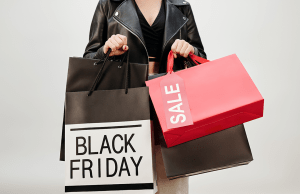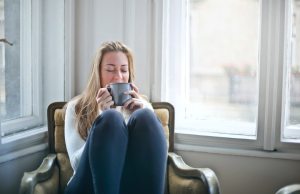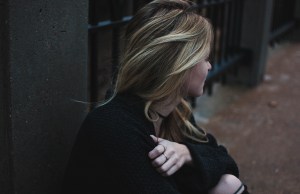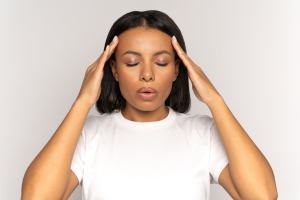
- The Black Friday shopping experience can be particularly stressful for people with anxiety due to sensory overload and consumer persuasion techniques.
- Marketers promote the illusion of scarcity during the height of the holiday shopping season, leading to additional anxiety and urgency.
- Anxious people can still shop pleasurably in person on Black Friday if they maintain their personal space and strategically time their outings.
- If Black Friday still seems overwhelming, anxious consumers can celebrate Buy Nothing Day or Small Business Saturday instead.
Some shoppers have nightmares about arriving at the big box store 5 minutes too late to snag the Black Friday doorbuster they came to buy. For other shoppers, a nightmare scenario is the Black Friday shopping itself. Consider this [Trigger Warning]: You walk through the automatic doors of a megamall and your senses are immediately assaulted. Screaming toddlers throw themselves at Santa Claus while their stressed-out parents fuss with buttons on their Christmas rompers. Herds of tweens TikTok their food court experiences. A line grows outside the women’s bathroom. And there’s more. Bubble gum machines. Mobile phone store kiosks outside mobile phone stores. Perfume kiosks outside perfume stores. Carousels. Recycled air. Holiday music. Flashing lights. Pumpkin spice x 1000.
It feels like chaos, but it’s very intentional. Retailers benefit from overwhelming task-oriented shoppers so their emotional, impulsive minds will take over the buying process. There’s actually a term for this sensory overload in retail spaces. It’s called the Gruen effect, after Victor Gruen, the inventor of the indoor mall. Though Gruen later regretted the “gigantic shopping machines” he created, his successors have only gotten better at manipulating consumers with artful “customer traps”—especially during the winter holidays. It’s enough to make even the most mellow shoppers anxious.
But people with preexisting anxiety have it especially rough on Black Friday. Here’s how to maintain your equilibrium and still get the deals you deserve this holiday season.

How Retailers Contribute to Holiday Anxiety
You’re a smart consumer. You’re aware of the ways in which advertisers try to ensnare you. Marketing tactics around the holidays are especially egregious, almost clinically calculated to incite buying frenzies. And Black Friday ad campaigns seem to launch earlier every year due to the infamous “Christmas creep”.
Stores know that you will inevitably spend loads of money on gifts. They know that you’re not necessarily loyal to their brand. And they also know that they need to hijack the critical thinking skills of all the task-oriented, intentional shoppers so they can be converted into wandering, romantic, easily distracted, socially-oriented shoppers who spend way more.
We’ve already covered some consumer manipulation techniques, but here’s one of those persuasion tactics writ large in holiday lights:
THE ILLUSION OF SCARCITY
(i.e. Black Friday is one day only so you must buy NOW before everything is SOLD OUT and Christmas is RUINED.)
This repeated messaging adds to a consumer’s sense of urgency and FOMO (fear of missing out). Retailers persuade people to buy their merchandise by advertising limited supplies and Black Friday-only offers. And the scarcity may very well be real, not just an illusion. Plenty of retailers use a very limited number of loss leaders (doorbusters) to entice customers onto the shopping floor. Once people are there, the customer’s natural sunk cost bias (tendency to double down on a bad investment) and loss aversion may prevent them from walking out, even if they miss the big deal. They’ve already made the trip, after all. Might as well buy something.
But for an anxious person, this manufactured sense of urgency can feel distressing to the point of decision paralysis. The illusion of scarcity might not energize the anxious person to act. Instead, it might entrench them further in fight-or-flight mode. They might go to the store irritable and combative, or avoid the deals altogether.
And anxious people can’t escape scarcity-based marketing tactics even if they opt for online shopping on Cyber Monday. Because consumers can’t see a physical line outside the virtual store that indicates other e-shoppers beat you to the scarce goods, online retailers rely on countdown clocks, product view numbers, and supply level indicators. On the one hand, this helps consumers manage their expectations. On the other hand, it makes them anxious to buy as quickly as possible before they miss out.
Lastly, retailers benefit from increased materialism at the holidays. They use environmental cues to make people more materialistic, a personality trait proven to increase competitiveness and self-serving behavior. This means more bad vibes for the shopper who’s already anxious in crowds.
Tips for Tranquil Black Friday Shopping
Now that you know how omnichannel Black Friday advertising can stoke anxiety (and knowledge is half the battle), let’s look at some survival tactics. In-person holiday shopping is still possible, even for people with anxiety. It just takes some planning and self-compassion. Here are some tips for conquering Black Friday with your sanity intact:
- Guard your bubble. First and foremost, maintain your physical distance from other shoppers whenever possible. Violations of personal space can arouse acute emotion, including anxiety and panic. If you have to go into a big box store, stick to the periphery. If you have to go into the mall, shop on the second level since people tend to gravitate downwards. You may benefit from shopping in smaller stores in the morning, then hitting the mall or big box stores in the afternoon, once the more fanatical shoppers have cleared out. Everyone has a different “boundary style”, especially due to the pandemic, so determine what your ideal personal space is and shop accordingly.
- Go with a friend. Many (non-anxious) shoppers compare Black Friday to Super Bowl Sunday. For them, it’s a huge, slightly outrageous social event. And it can still be a social event for an anxious shopper, but you might prefer to shop with one friend rather than a raucous group. The friend can help protect your personal space, recognize when you’re feeling overwhelmed, and have a coffee with you when you need a breather.
- Plan for quick getaways. Upon entering a store, identify the locations of the bathrooms and exits. Now you know you can escape if the need arises.
- Research. Look at the store’s website in advance. You’ll still get the in-person, brick and mortar browsing experience, but you’ll have a better idea of what to expect.
- Shop in small doses. Give yourself time to recover between stores. Take a nap in your car if you have to.
- Use an active coping strategy. In other words, reduce your stress through positive planning. For example, you can focus on sticking to your budget or editing your list as you shop. Or you could seek out a salesperson to help you navigate through the aisles.
- Wear headphones. Your favorite music might calm you while you shop. Or you can wear the sweet, noise-cancelling headphones that you got a great deal on last Black Friday. Just make sure you’re shopping in a safe place before you block out the rest of the world.
- Quiet your ego. When you have self-compassion, you don’t judge yourself for having anxiety. When you have a “quiet ego”, you’re less concerned with material things and more concerned with connecting to others and growing as a person. So if you enter a store with self-compassion and a quiet ego, you’re likely to be more mindful, less competitive, and perhaps even less anxious.
Practicing Homebody Economics
Holiday shopping should be pleasurable and fulfilling. This Black Friday, remember that no deal is worth the sacrifice of your mental health and wellbeing. You might save some money by stampeding through Walmart at 4am, but at what cost? If you’re anxious in crowds, peak retail season might not be the time to practice exposure therapy. Plus, there are alternatives to Black Friday:
- Buy Nothing Day: This day is an alternative to Black Friday that also takes place on the Friday after Thanksgiving. It’s a movement meant to draw attention to the harms of overconsumption. Celebrants of Buy Nothing Day can simply forsake purchases for 24 hours, or they can participate in protests like “Whirl-Mart”, when, according to Wikipedia, people “silently steer their shopping carts around a shopping mall or store in a long conga line without putting anything in the carts or actually making any purchases.”
- Small Business Saturday: Small businesses keep communities alive! And as a bonus for anxious people, small businesses tend to play their music at much lower decibels than shopping malls.
- Giving Tuesday: This global generosity movement encourages people to give back to their communities via donations or volunteering on the Tuesday after Thanksgiving.
- Collaborative consumption: This is the idea that goods stay in circulation and are shared between consumers, as when you buy something at a garage sale or on Facebook Marketplace.
- Sustainable consumption: This is when you consider the overall environmental impact of your purchases. For instance, you don’t buy products that have planned obsolescence, i.e., you’ll need to replace them in a year.
- Opt Outside: The outdoor retailer REI closes its stores on Black Friday and urges its customers to spend the day in nature. This is strategic marketing, sure, but it’s also pretty honorable.
And of course there’s the Monday after Thanksgiving—Therapy Day—when (in our experience) more people inquire about and/or schedule a counseling appointment than any other day of the year. Gosh, I wonder if this has something to do with the pumpkin spice x 1000.













